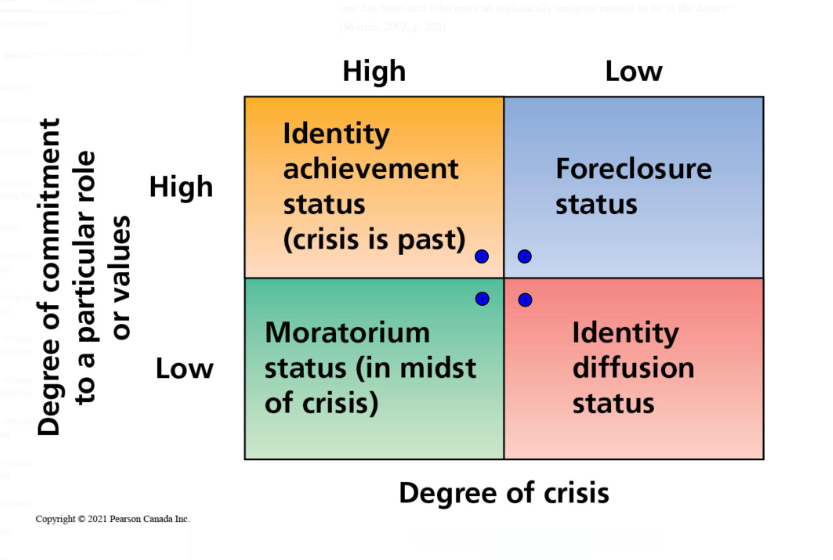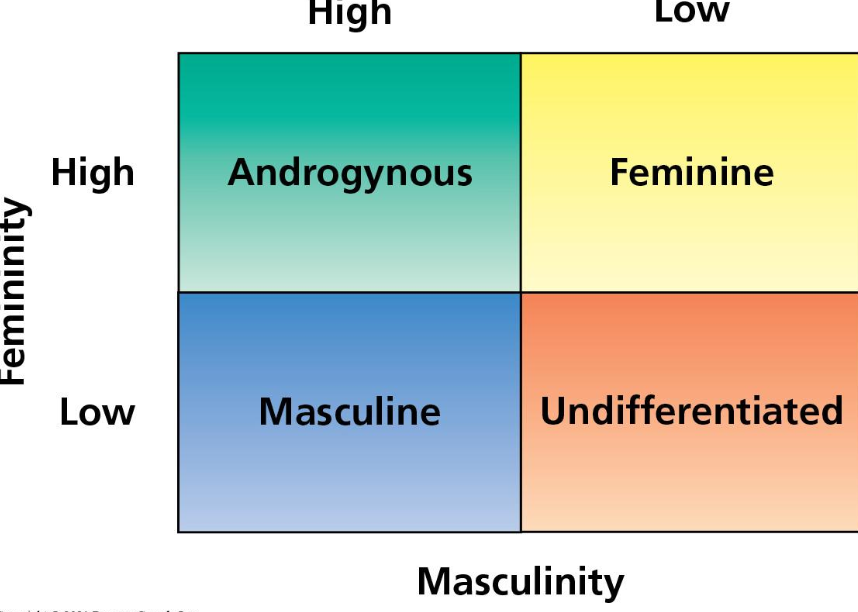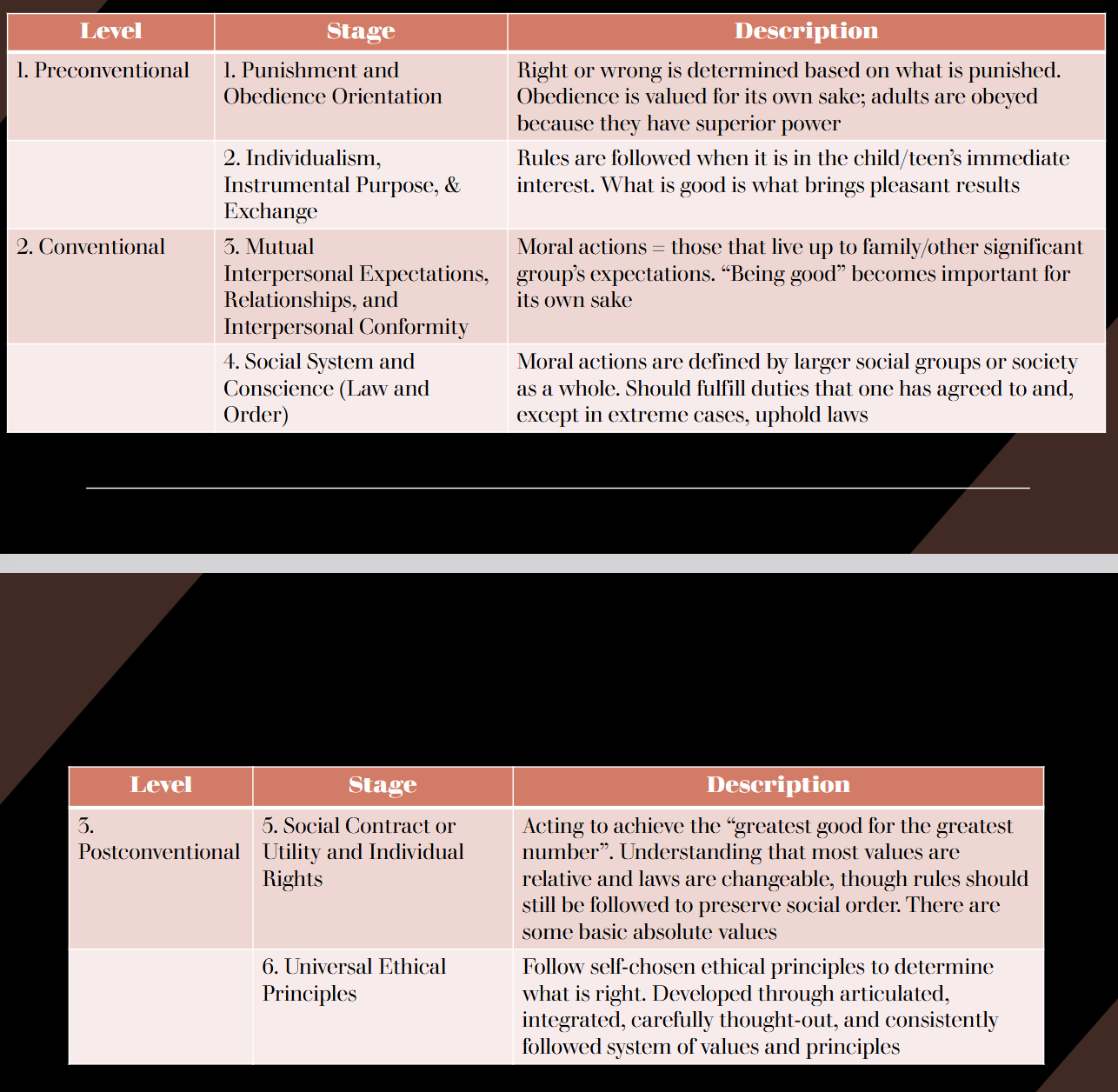13. Adolescence - Social and Personality Development
1/30
There's no tags or description
Looks like no tags are added yet.
Name | Mastery | Learn | Test | Matching | Spaced |
|---|
No study sessions yet.
31 Terms
Rites of passage
Theories
______________- Absence of formal rites of passage lead to more risky behaviours as teens attempt to invent their own rites of passage
What the rite looks like depends on the peer group and can be positive or negative
Adolescents work to transition to adulthood, but adult guidance and support is important
Freud → Genital Stage (OAPLG)
Theories
____________- Focus is on emergence of romantic interest. Stage during which individuals reach psychosexual maturity
Puberty reawakens sexual drive that was dormant during latency stage
Primary task is to channel libido into healthy sexual relationship
Erik Erikson → Identity vs. Role Confusion
Theories
_________ - Agreed that achieving sexual maturity was important. Thought achievement of personal identity more critical task
Identity
Identity
___________ - understanding of one’s unique characteristics and how they are manifested across ages, situations, and social roles
Marcia’s Theory of Identity Achievement
Theories
______________ - Research confirmed Erikson’s general conceptions of adolescent identity process
Marcia proposed two parts to identity formation:
Crisis
Commitment
Four identity statuses defined by degree of commitment to particular role or values and degree of crisis

Identity development
Identity
_________________ - Identity formation occurs later than Erikson and Marcia thought. Cognitive development strongly related— Identity statuses fluctuate during adolescence
Quest for identity continues across lifespan
Unique feature of adolescence: first time all key elements are present
Adultification
Adultification
Identity development
____________ - child or adolescent prematurely takes on adult roles and responsibilities
Risk factors: parental discord, cultural disruption, family economic hardship, caregiver trauma
Consequences: range of psychosocial and mental health outcomes
Psychological self
Self-concept
_______________ - More focused on enduring internal characteristics. Self-definition becomes more abstract
Cyclical relationship with Big Five personality traits
Becomes more differentiated
Begin to influence behaviour
Academic self-concept
Academic self-concept
Self-concept → psychological self
_____________ - Comes from internal and external comparisons. Perceived competency in one area affects perceptions of abilities in other areas
Social self-concepts also predicts behaviour
Self-esteem + gender role identity
Self-esteem
______________ - Influenced by: personal characteristics, relationships with others, school, lifestyle factors, achievements
Gender role identity = gender-related aspects of psychological self
Understand that gender roles are social conventions
Parental influence becomes increasingly strong
Concept that were separate become integrated into conceptual framework
Androgynous and masculine gender role identities are associated with higher self-esteem among boys and girls
Sexism and patriarchy reduce wellness of feminine girls
Bem Sex-Inventory Index (BSRI)
High Femininity | Low Femininity | |
|---|---|---|
High Masculinity | Androgynous | Masculine |
Low Masculinity | Feminine | Undifferentiated |

Ethnic identity
_______________ - sense of belonging to an ethnic group
Can conflict with a social environment dominated by concerns of the majority
BIPOC teens must create an understanding of their multiple identities
Phinney’s three stages of ethnic identity
Ethnocultural identity
Phinney’s 3 Stages of Ethnic Identity
Ethnic identity
Unexamined ethnic identity
Ethnic identity search
Ethnic identity achievement
Ethnocultural identity
Ethnic identity
_______________ - transmitted and acquired from society in which one is raised
Kohlberg’s Theory of Moral Reasoning
_______________ - Founded on Piaget’s two stages. Measured moral reasoning through participant responses to moral dilemmas
Three levels (each with two stages):
Preconventional
Conventional
Postconventional
Justification, not choice itself, determines stage
Stages loosely correlated with age— Sequence is universal and hierarchical
Social environment determines speed at which individuals progress
Emergence of higher stages strongly influenced by formal education

1) Preconventional level
Kohlberg’s Theory of Moral Reasoning
_______________ - first stage
Punishment and Obedience Orientation: Right or wrong is determined based on what is punished. Obedience is valued for its own sake; adults are obeyed because they have superior power
Individualism, Instrumental Purpose, & Exchange: Rules are followed when it is in the child/teen’s immediate interest. What is good is what brings pleasant results
2) Conventional level
Kohlberg’s Theory of Moral Reasoning
________________ - second stage
Mutual Interpersonal Expectations, Relationships, and Interpersonal Conformity: Moral actions = those that live up to family/other significant group’s expectations. “Being good” becomes important for its own sake
Social System and Conscience (Law and Order): Moral actions are defined by larger social groups or society as a whole. Should fulfill duties that one has agreed to and, except in extreme cases, uphold laws
3) Postconventional level
Kohlberg’s Theory of Moral Reasoning
________________ - third stage
Social Contract or Utility and Individual Rights: Acting to achieve the “greatest good for the greatest number”. Understanding that most values are relative and laws are changeable, though rules should still be followed to preserve social order. There are some basic absolute values
Universal Ethical Principles: Follow self-chosen ethical principles to determine what is right. Developed through articulated, integrated, carefully thought-out, and consistently followed system of values and principles
Causes/consequences of moral development
Kohlberg’s Theory of Moral Reasoning
_______________ - Cognitive development explains association between stages and age.
Kohlberg thought decline in egocentrism is most critical cognitive variable for moral reasoning
Research supports relationship between role-taking and moral development
Supportive social environment also necessary
Parent’s ability to identify, understand, and respond to child’s less mature level of reasoning = critical to development of moral reasoning
Association with prosocial behaviour
Criticisms of Kohlberg’s theory
Kohlberg’s Theory of Moral Reasoning
_____________ - Cross-cultural research provides support for the universality of Kohlberg’s stages; some contend however that his approach was too narrow
Researchers focused on the link between moral reasoning and moral emotions also criticize his approach as being too narrow
Questioning of degree to which moral reasoning predicts moral behaviour
Moral development + antisocial behaviour
Moral development
_____________ - Adolescents who engage in serious forms of antisocial behaviour typically have low levels of moral reasoning
Teens who act aggressively typically lack empathy and are particularly vulnerable to situational factors that contribute to poor moral decision-making
Criminality
Youth Criminal Justice Act shifted focus to the young person’s actions
Criminality
Moral development and antisocial behaviour
_______________ - forms of antisocial behaviour that involve breaking the law
Conduct disorder
Moral development and antisocial behaviour
_____________ - may be diagnosed among children and youth who display a consistent pattern of antisocial behaviour
Childhood-onset: more serious and persistent symptoms, directed by internal factors
Adolescent-onset: more transitory, likely a reflection of peer-group processes or testing limits of authority
Risk factors for adolescent-onset conduct disorder
Moral development and antisocial behaviour → adolescent-onset conduct disorder
_______________ - Personality and social variables
Personality: low agreeableness, low emotion regulation, high neuroticism, narcissism
Social variables: insufficient parental monitoring, parents with histories of antisocial behaviour, unsupportive or non-intimate friendships, peer groups with drug and mild lawbreaking experimentation
Relationships w/ parents
_________________ - Conflict between establishing autonomy and maintaining sense of relatedness.
Rise in conflict— does not actually represent a major disruption in the quality of the relationship. Causes more distress to parents than to teen
Attachment typically remains strong; biggest predictor of teen’s sense of well-being or happiness
Teens who remain close with parents have better academic achievement, good peer relations, and are less likely to engage in antisocial behaviour or use drugs
Relationships w/ peers
_______________ - Wider range of acquaintances due to tech; however no associated increase in close friendships
Belief in importance of popularity and peer acceptance peaks during early adolescence— Quality of friendships become more important in later adolescence
Friendship stability increases
Teens tend to choose friends who share their social status
Rate of social skills development influences friendship longevity
Peer groups become relatively stable
Cliques
Changes in peer group structure
______________ - Four-to-six young people who appear to be strongly attached to one another
Strongly cohesive and high levels of intimate sharing; lots of within-group aggression to maintain group’s status hierarchies
Early adolescence: primarily same-gender; overtime, combine into → CROWDS
Crowds
Changes in peer group structure
_____________ - include a range of gender identities— break down into mixed-gender cliques
Mixed-gender cliques break down into loose associations of couples
Heterosexual teens
Romantic relationships
_______________ - Change from same-gender friendships to heterosexual relationships happens more quickly for girls
Early adolescence: gradual openness to other-gender friendships through which skills for romantic relationships are gained
Romantic relationships become common ~age 15 years
Cross-cultural variations
Teens of lower SES and who experience earlier puberty are more likely to date and engage in sexual activity
Religious influence, family structure, and individual attitudes also influence
2SLGBTQ+ sexually-oriented
Romantic relationships
______________ - Teens must come out to themselves and then (sometimes) to others
Prevalence of teens coming out to parents and peers is increasing
Parental acceptance associated with greater self-esteem, social support, better health, and lower depression, substance use, and suicidal ideation and attempts
Tend to act on sexual attraction sooner
Classifying oneself at ~15 years sometimes preceded by period of sexual discovery and experimentation
Asexual and aromantic
Romantic relationships
______________ - Individuals who identify as asexual and/or aromantic can be of any gender identity
Asexual: do not experience sexual attraction
Aromantic: do not experience romantic attraction
Teens must come out to themselves and then (sometimes) to others